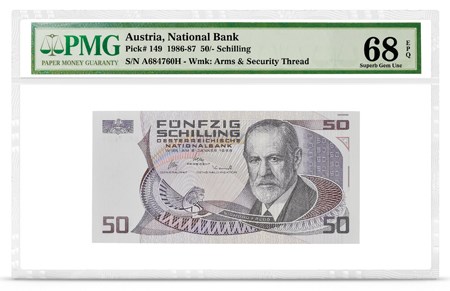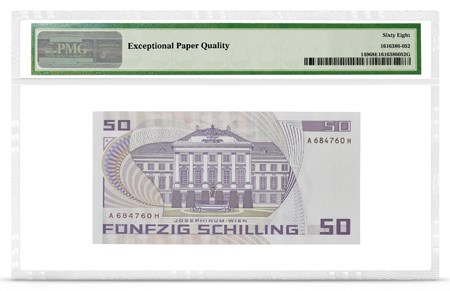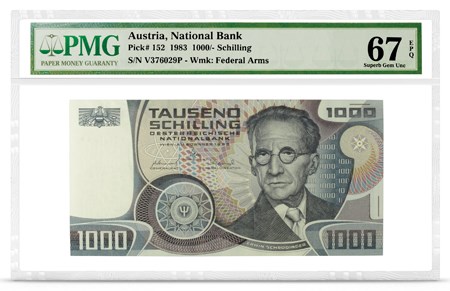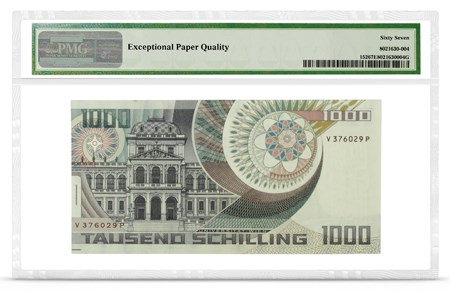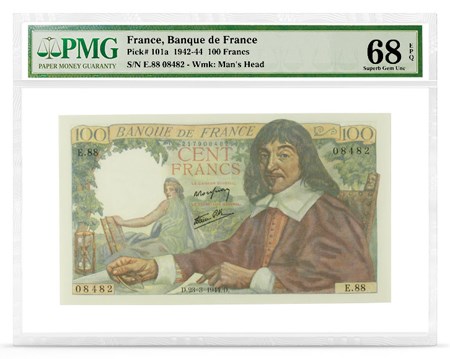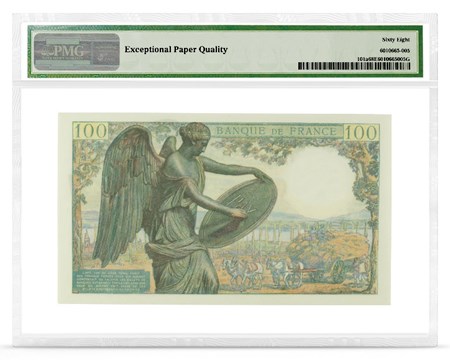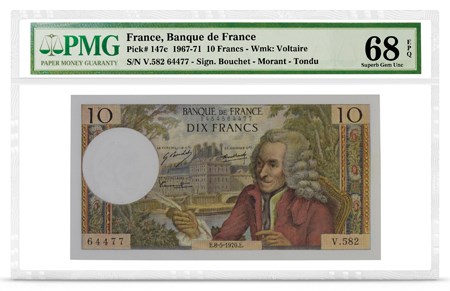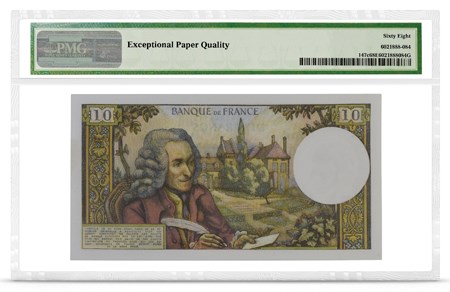Psychologists, Philosophers & Scientists on Banknotes
Posted on 5/16/2017
Last year, we highlighted notes featuring artists and composers. This month we are featuring four notes commemorating the accomplishments of psychologists, philosophers and scientists.
In 1982, Austria’s National Bank redesigned their banknotes with a new group of notable Austrians, such as Wolfgang Amadeus Mozart. The 50 Schilling note was issued with Sigmund Freud’s portrait on the front and the Josephinum Hospital in Vienna on the back. The note was in circulation from 1987 to 2002, with a printed date of January 2, 1986. According to the PMG census, the highest graded examples are three notes at 68 EPQ, one of which is pictured above. Sigmund Freud is best known for developing psychoanalysis, which revolutionized the relationship between the psychoanalyst and the patient. His lasting influence with respect to concepts such as the oedipal complex and the libido is still being felt today. In addition, the term “Freudian slip” has further propagated Freud and his theories long after his death and has cemented itself in everyday conversation.
As part of the aforementioned 1982 redesign, the Austrian 1,000 Schilling note featured Erwin Schrödinger on the front and his alma mater, the University of Vienna, on the back. The note was in circulation from 1983 to 1997, and is scheduled for demonetization on April 20, 2018 as a result of Austria’s transition to the euro, which began in 1999. According to the PMG census, the highest graded example is one note at 68 EPQ. Erwin Schrödinger was a physicist who won the Nobel Prize in 1933 for the formulation of what is now referred to as the Schrödinger equation. The equation has been heralded as significant in the field of quantum mechanics, but more are likely to know the term “Schrödinger’s cat.” This refers to a thought experiment in which a cat is poisoned when radioactivity is detected. Schrödinger supposed that the cat is both alive and dead, as the atoms of the cat and the molecules in its immediate atmosphere render the cat as existing in both states.
In 1941, French banknotes were updated. The 100 Franc note was also designed to include a portrait of René Descartes on the front and an angel writing “PAX” (Latin for “peace”) on the back. The note was in circulation from 1942 to 1945, although the last dated note is December 12, 1944. According to the PMG census, the highest graded example is one note at 68 EPQ. René Descartes is often referred to as the father of modern western philosophy. His statement “cogito ergo sum” (“I think, therefore I am”) is still widely known today. Descartes is also credited with bringing algebra and geometry together in what is known as analytical geometry. He “invented the convention of representing unknowns in equations by x, y, and z, and knowns by a, b, and c.”1 The Cartesian coordinate system, and its graph with x and y axis are based on his work.
In January 1960, French President Charles de Gaulle reformed his nation’s currency, introducing the Nouveaux Franc (New Franc), which was equivalent to 100 regular francs. These notes were in circulation until 1962, at which time France returned to the regular franc. This return also brought all new portraits of notable Frenchmen, including Voltaire who is featured on the front and back of the 10 Franc note. This note circulated from 1963 to 1973. According to the PMG census, there are four varieties, delineated by date, with the highest graded example being 68 EPQ, one of which can be seen above. Voltaire was a writer, historian and philosopher during the 18th century French Enlightenment period. This era matched Voltaire’s writing, as many during the period advanced ideals such as separation of church and state and individual liberty. Among historians, Voltaire was influential in developing historiography, which studies how historians approach their field. Voltaire “reject[ed] traditional biographies and accounts that claim the work of supernatural forces, but he went so far as to suggest that earlier historiography was rife with falsified evidence and required new investigations at the source.”2
In conclusion, there are many interesting historical figures that have been featured on banknotes. As we have seen with the above examples, the path to discovery or enlightenment often comes through unconventional means. There are too many to list here, but hopefully you will take the time to look through your collection and discover the stories beyond the banknote.
Sources:
1. Sorell, Tom. (2000). A Very Short Introduction. New York: Oxford University Press, p. 19. 2. Boyd, Kelly. (1999). Encyclopedia of Historians & Historical Writing, Volume 2. London: Fitzroy Dearborn Publishers, pgs. 1270-72.
Stay Informed
Want news like this delivered to your inbox once a month? Subscribe to the free PMG eNewsletter today!
